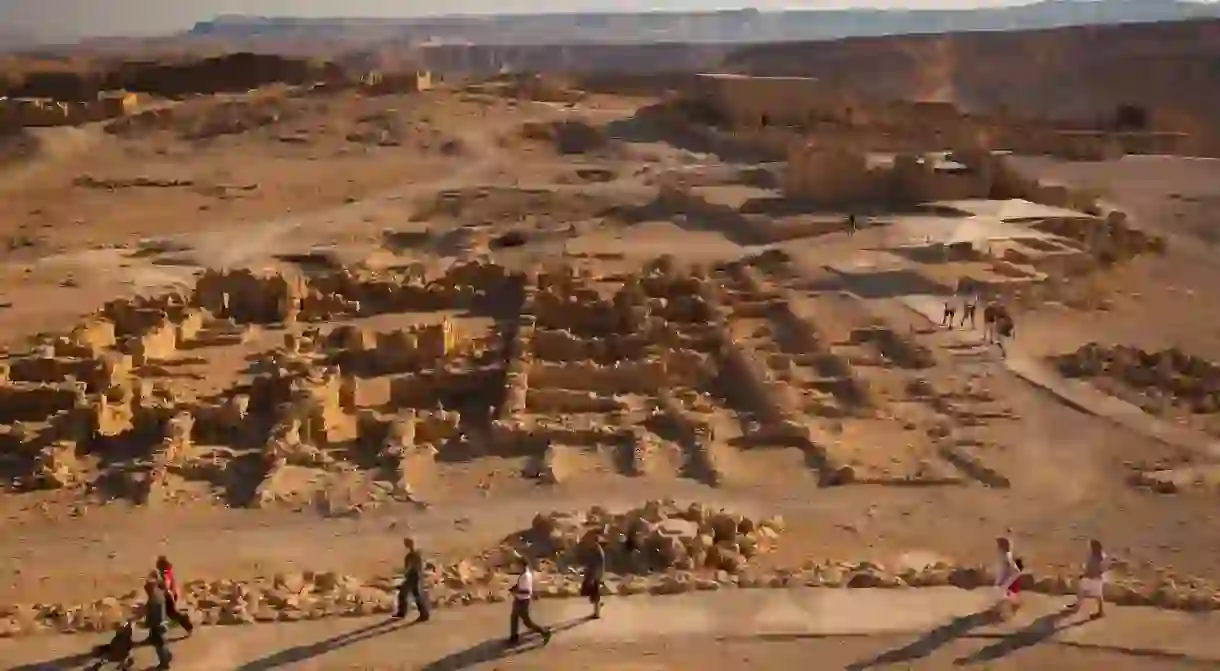Top Things To Do In The Negev Desert, Israel

Israel’s Negev Desert is often an overlooked area of the country that has more to offer than most people realize. From stunning desert landscapes to ancient ruins, the Negev is full of treasures that merit exploration. Plan to add a visit to the Negev on your next trip to Israel and make sure to enjoy these sites and activities.
Tel Be’er Sheva
Tel Be’er Sheva is an archaeological site of the biblical town of Beersheba. The ruins of the ancient town have been preserved and have become the Tel Be’er Sheva National Park. The site was recognized as a UNESCO World Heritage Site in 2007, and today, visitors visit the park to explore the ruins and experience ancient history firsthand. The highlight that draws the most visitors is Abraham’s Well. While this was not a well used by Abraham, it is reminiscent of the one Abraham dug in Genesis 21. Near Be’er Sheva is the Hatzerim Air Force Base, which houses the Israeli Air Force Museum. This museum is not to be missed by anyone interested in aircraft or military history.

Ramon Crater
The Ramon Crater is one of the Negev Desert’s most famous geological features. Often mistakenly believed to be the result of a meteor impact, this immense crater is actually a type of geological landform known as a makhtesh. These unique landforms are only found in Israel’s Negev Desert and Egypt’s Sinai Peninsula. Not only is the Ramon Crater the largest makhtesh in the world, but it’s also Israel’s largest national park, the Ramon Nature Reserve. The Mitzpe Ramon Visitor Center offers interactive exhibits that describe how the makhtesh was created as well as an introduction to the flora and fauna of the area.
Kibbutz Sde Boker
Located in the Northern Negev Mountains is Kibbutz Sde Boker. Built in 1952, this community was the vision of Israel’s first Prime Minister, David Ben Gurion. He encouraged Israelis to settle in the Negev Desert, which was sparsely populated at the time, by founding Sde Boker and moving there with his wife. He remained there until his death, and today, his hut has been preserved and transformed into a museum dedicated to his life.
Sde Boker Schools and Grave Site
Located near Kibbutz Sde Boker is Sde Boker Field School, which provides visitors with an ecological education. Also in the area is Midreshet or Midrash, which means ‘a place of learning,’ an education center that was the vision of Ben Gurion and a place where researchers come to study the Negev Desert. The grave site of Ben Gurion and his wife Paula are also here, and the memorial site can be visited by travelers.
Wine Tasting
Wine makers in the Negev have been implementing drip irrigation techniques to grow flourishing vineyards and produce wine since the 1990s. But these modern winemakers are not the first to cultivate grapes in this region. The ancient Nabataeans used ancient irrigation systems to grow grapes in the arid Negev Desert. Considering that the Negev receives less than 100 mm of rain each year, this is certainly an impressive accomplishment. Wine enthusiasts travel along the wine route along Route 40 to enjoy an assortment of varietals including merlots, zinfandels, blends, and sauvignon blancs.

Off Roading and Trail Hikes
The expansive landscape of the Negev offers a paradise for hiking enthusiasts. With a seemingly limitless array of trails available, there is a hike for everyone, from the novice to the expert. Trails are marked by color-coded markers in order to keep hikers from getting lost. One of the most popular hiking areas is Ein Avdat, a gorgeous canyon with waterfalls, natural springs, and deep pools. For adventurists who want to experience the desert beauty of the Negev off the beaten path, off roading is an exciting option. Jeep trails abound in the Negev, and there are several companies that offer jeep tours.
Camel Rides & Bedouin Hospitality
The Bedouins are a nomadic people with a rich and intriguing lifestyle. Throughout the Negev Desert, there are places where visitors can get a taste of the Bedouin way of life. Bedouin hospitality often includes providing camel rides, traditional cuisine, and an opportunity to sip tea or coffee while reclining in the colorful, blanket-filled tents.
Avdat
Most people have heard of the Nabataean city of Petra, the most important stop on the ancient Incense Route. But Avdat was a city along the route of nearly equal importance to the ancient Nabataeans, Romans, and Byzantines. Today the ruins are considered a UNESCO World Heritage Site and draw visitors from around the world. The most famous site among the ruins is the Temple of Oboda, which served as a place to worship the deified Nabataean king, Obodas II.
Timna Park
Approximately 20 miles north of Eilat is the beautiful Timna Valley. An area rich in copper ore, Timna has been mined since before the time of Christ. The valley is well known for its unique geological features and striking desert landscape. Perhaps most famous are Solomon’s Pillars, natural pillars that formed in the sandstone cliffs.
Yotvata Hai-Bar Nature Reserve
The Yotvata Hai-Bar Nature Reserve is dedicated to breeding and reacclimating animals mentioned in the Bible that have become endangered or locally extinct. Visitors can drive through the reserve and observe the animals from their car as well as enjoy an up-close encounter at the reserve’s mini zoo. Among the animals bred here are the Arabian oryx, red-necked ostrich, Asian wild ass, Arabian leopard, South African cheetah, Arabian wolf, striped hyena, and more.
Did you know – Culture Trip now does bookable, small-group trips? Pick from authentic, immersive Epic Trips, compact and action-packed Mini Trips and sparkling, expansive Sailing Trips.













